|
Featured picture tools: |
These featured pictures, as scheduled below, appeared as the picture of the day (POTD) on the English Wikipedia's Main Page in September 2018. Individual sections for each day on this page can be linked to with the day number as the anchor name (e.g. [[Wikipedia:Picture of the day/September 2018#1]] for September 1).
You can add an automatically updating POTD template to your user page using {{Pic of the day}} (version with blurb) or {{POTD}} (version without blurb). For instructions on how to make custom POTD layouts, see Wikipedia:Picture of the day.
September 1
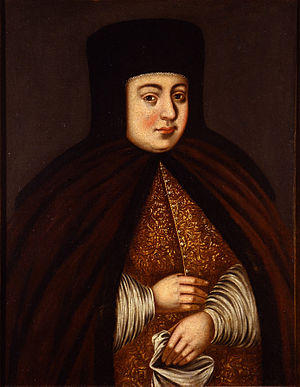
|
Natalya Naryshkina (1651–1694) was the Tsaritsa of Russia from 1671–1676 as the second spouse of Tsar Alexis I of Russia. She was the mother of Tsar Peter I of Russia (Peter the Great), who was born in 1672. Painting: Anonymous
Recently featured:
|
September 2

|
A Man with a Quilted Sleeve is a portrait painting by the Venetian painter Titian in the National Gallery in London. The identity of the subject is unknown. For many years, it was thought to be the poet Ludovico Ariosto. More recent research suggests that it may be of a man from the Barbarigo family of Venice, or even a self-portrait. Rembrandt copied the pose for his own Self-portrait at the age of 34. Painting: Titian
Recently featured:
|
September 3

|
The western honey bee (Apis mellifera) is the most common of the 7–12 species of honey bee worldwide. It is believed to have originated in either Africa or Asia, and spread naturally through Africa, the Middle East and Europe. Following human introduction into the Americas and Oceania, the species is now found on every continent except Antarctica. Humans have been collecting honey from bees for thousands of years, with evidence in the form of rock art found in France and Spain, dating to around 7000 BC. Along with other insects, the honey bee is an important pollinator, with a large number of the crop species farmed worldwide depending on it. Photograph: Martin Falbisoner
Recently featured:
|
September 4

|
The Madrid Metro is a rapid transit system serving the Spanish capital, Madrid. It was inaugurated in 1919 by King Alfonso, with a single line which ran for 3.48 km (2.16 mi) between Puerta del Sol and Cuatro Caminos, with eight stops. The present system has 301 stations on 13 lines plus one branch line, totalling 294 km (183 mi). Map: Javitomad
Recently featured:
|
September 5

|
Johann Christian Bach (5 September 1735 – 1 January 1782) was a composer of the Classical era, the eighteenth child of Johann Sebastian Bach, and the youngest of his eleven sons. Bach was taught by his father and then, after the latter's death, by his half-brother C. P. E. Bach. Bach moved to Italy in 1754, and then to London in 1762, where he became known as the "London Bach". Bach's compositions include eleven operas, as well as chamber music, orchestral music and compositions for keyboard music. In 1764 Bach met Wolfgang Amadeus Mozart, who was eight at the time, and spent five months teaching him composition. He had considerable influence on Mozart, and was later described by scholars as his "only, true teacher". This portrait of Bach was painted in 1776 by Thomas Gainsborough, as part of a collection started by Bach's former teacher Padre Martini. It now hangs in the National Portrait Gallery, London. Painting: Thomas Gainsborough
Recently featured:
|
September 6

|
The Game.com is a fifth-generation handheld video game console manufactured by Tiger Electronics. Designed as a competitor to Nintendo's Game Boy series, it was released in September 1997. It sold less than 300,000 units and was discontinued in 2000 as a commercial failure. Photograph: Evan Amos
Recently featured:
|
September 7

|
The flugelhorn is a brass instrument which is usually pitched in B♭. It resembles a trumpet, with a tube of the same length but a wider, conical bore. A type of valved bugle, the flugelhorn was developed in Germany from a traditional English valveless bugle, with the first version sold by Heinrich Stölzel in Berlin in 1828. Photograph: Yamaha Corporation
Recently featured:
|
September 8
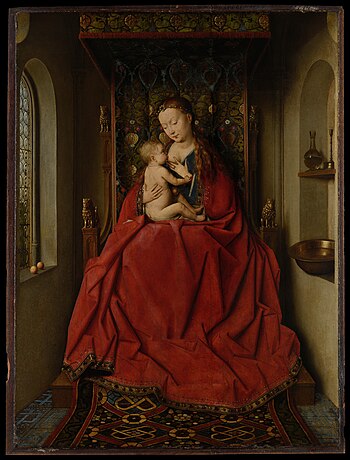
|
The Lucca Madonna is a 1437 oil painting of the Madonna and Child by the Early Netherlandish master Jan van Eyck. It shows Mary seated on a wooden throne crowned by a canopy, with four small lion statues made of brass. This is a reference to the throne of Solomon, which had twelve lions on the sides and steps. She is breastfeeding the infant Jesus. The painting is in the Städel Museum in Frankfurt, Germany. Painting: Jan van Eyck
Recently featured:
|
September 9

|
Leo Tolstoy (1828–1910) was a Russian writer who is regarded as one of the world's greatest novelists. He is best known for War and Peace (1869) and Anna Karenina (1877), often cited as pinnacles of realist fiction. Born to an aristocratic family on 9 September [O.S. 28 August] 1828, Tolstoy was orphaned when he was young. He studied at Kazan University, but this was not a success, and he left university without completing his degree. During this time, he began to write and published his first novel, Childhood, in 1852. Tolstoy later served at the Siege of Sevastopol during the Crimean War, and was appalled by the number of deaths and left at the conclusion of the war. He spent the remainder of his life writing whilst also marrying and starting a family. In the 1870s he converted to a form of fervent Christian anarchism. Photograph: F. W. Taylor; restoration: Yann
Recently featured:
|
September 10

|
|
The Veil Nebula is a cloud of heated and ionized gas and dust in the constellation Cygnus. Together with various other nebulae, it makes up the visible portions of the Cygnus Loop, a supernova remnant and strong emitter of radio waves and X-rays. The source supernova event occurred around 8,000 years ago when a star 20 times more massive than the Sun exploded. The remnants have since expanded to cover an area of the sky with a diameter roughly six times that of the full Moon. The distance to the Veil Nebula is not precisely known, but Far Ultraviolet Spectroscopic Explorer data supports a distance of about 1,470 light-years. Analysis of the emissions from the nebula indicates the presence of oxygen, sulfur, and hydrogen. Photographer: Ken Crawford
Recently featured:
|
September 11
Subpage 1

|
A double eagle is a gold coin of the United States with a denomination of $20. The first double eagle, known as the Liberty Head, was minted from 1849, coinciding with the California Gold Rush. In 1904, President Theodore Roosevelt asked artist Augustus Saint-Gaudens to produce a new coin in an effort to beautify American coinage. The new coin became known as the Saint-Gaudens, and was produced until 1933. The 1933 double eagle is among the most valuable of U.S. coins, with the sole example currently known to be in private hands selling in 2002 for $7,590,020. The coin pictured is an 1849 Liberty Head. See other double eagle coins: 1866 Liberty Head; 1877 Liberty Head; 1907 Saint Gaudens (Roman, high relief; Roman, ultra high relief, wire edge; Arabic; Arabic and motto; edge detail); 1933 Saint Gaudens Coins: U.S. Mint, National Numismatic Collection, National Museum of American History.
Recently featured:
|
Subpage 2

|
A double eagle is a gold coin of the United States with a denomination of $20. The first double eagle, known as the Liberty Head, was minted from 1849, coinciding with the California Gold Rush. In 1904, President Theodore Roosevelt asked artist Augustus Saint-Gaudens to produce a new coin in an effort to beautify American coinage. The new coin became known as the Saint-Gaudens, and was produced until 1933. The 1933 double eagle is among the most valuable of U.S. coins, with the sole example currently known to be in private hands selling in 2002 for $7,590,020. The coin pictured is an 1866 Liberty Head. See other double eagle coins: 1849 Liberty Head; 1877 Liberty Head; 1907 Saint Gaudens (Roman, high relief; Roman, ultra high relief, wire edge; Arabic; Arabic and motto; edge detail); 1933 Saint Gaudens Coins: U.S. Mint, National Numismatic Collection, National Museum of American History.
Recently featured:
|
Subpage 3

|
A double eagle is a gold coin of the United States with a denomination of $20. The first double eagle, known as the Liberty Head, was minted from 1849, coinciding with the California Gold Rush. In 1904, President Theodore Roosevelt asked artist Augustus Saint-Gaudens to produce a new coin in an effort to beautify American coinage. The new coin became known as the Saint-Gaudens, and was produced until 1933. The 1933 double eagle is among the most valuable of U.S. coins, with the sole example currently known to be in private hands selling in 2002 for $7,590,020. The coin pictured is an 1877 Liberty Head. See other double eagle coins: 1849 Liberty Head; 1866 Liberty Head; 1907 Saint Gaudens (Roman, high relief; Roman, ultra high relief, wire edge; Arabic; Arabic and motto; edge detail); 1933 Saint Gaudens Coins: U.S. Mint, National Numismatic Collection, National Museum of American History.
Recently featured:
|
Subpage 4

|
A double eagle is a gold coin of the United States with a denomination of $20. The first double eagle, known as the Liberty Head, was minted from 1849, coinciding with the California Gold Rush. In 1904, President Theodore Roosevelt asked artist Augustus Saint-Gaudens to produce a new coin in an effort to beautify American coinage. The new coin became known as the Saint-Gaudens, and was produced until 1933. The 1933 double eagle is among the most valuable of U.S. coins, with the sole example currently known to be in private hands selling in 2002 for $7,590,020. The coin pictured is a 1907 Saint Gaudens with Roman numerals and high relief. See other double eagle coins: 1849 Liberty Head; 1866 Liberty Head; 1907 Saint Gaudens (Roman, ultra high relief, wire edge; Arabic; Arabic and motto; edge detail); 1933 Saint Gaudens Coins: U.S. Mint, National Numismatic Collection, National Museum of American History.
Recently featured:
|
Subpage 5

|
A double eagle is a gold coin of the United States with a denomination of $20. The first double eagle, known as the Liberty Head, was minted from 1849, coinciding with the California Gold Rush. In 1904, President Theodore Roosevelt asked artist Augustus Saint-Gaudens to produce a new coin in an effort to beautify American coinage. The new coin became known as the Saint-Gaudens, and was produced until 1933. The 1933 double eagle is among the most valuable of U.S. coins, with the sole example currently known to be in private hands selling in 2002 for $7,590,020. The coin pictured is a 1907 Saint Gaudens with Roman numerals, ultra high relief and wire edge. See other double eagle coins: 1849 Liberty Head; 1866 Liberty Head; 1877 Liberty Head; 1907 Saint Gaudens (Roman, high relief; Arabic; Arabic and motto; edge detail); 1933 Saint Gaudens Coins: U.S. Mint, National Numismatic Collection, National Museum of American History.
Recently featured:
|
Subpage 6

|
A double eagle is a gold coin of the United States with a denomination of $20. The first double eagle, known as the Liberty Head, was minted from 1849, coinciding with the California Gold Rush. In 1904, President Theodore Roosevelt asked artist Augustus Saint-Gaudens to produce a new coin in an effort to beautify American coinage. The new coin became known as the Saint-Gaudens, and was produced until 1933. The 1933 double eagle is among the most valuable of U.S. coins, with the sole example currently known to be in private hands selling in 2002 for $7,590,020. The coin pictured is a 1907 Saint Gaudens with Arabic numerals. See other double eagle coins: 1849 Liberty Head; 1866 Liberty Head; 1877 Liberty Head; 1907 Saint Gaudens (Roman, high relief; Roman, ultra high relief, wire edge; Arabic and motto; edge detail); 1933 Saint Gaudens Coins: U.S. Mint, National Numismatic Collection, National Museum of American History.
Recently featured:
|
Subpage 7

|
A double eagle is a gold coin of the United States with a denomination of $20. The first double eagle, known as the Liberty Head, was minted from 1849, coinciding with the California Gold Rush. In 1904, President Theodore Roosevelt asked artist Augustus Saint-Gaudens to produce a new coin in an effort to beautify American coinage. The new coin became known as the Saint-Gaudens, and was produced until 1933. The 1933 double eagle is among the most valuable of U.S. coins, with the sole example currently known to be in private hands selling in 2002 for $7,590,020. The coin pictured is a 1907 Saint Gaudens with Arabic numerals and the U.S. motto. See other double eagle coins: 1849 Liberty Head; 1866 Liberty Head; 1877 Liberty Head; 1907 Saint Gaudens (Roman, high relief; Roman, ultra high relief, wire edge; Arabic; edge detail); 1933 Saint Gaudens Coins: U.S. Mint, National Numismatic Collection, National Museum of American History.
Recently featured:
|
Subpage 8

|
A double eagle is a gold coin of the United States with a denomination of $20. The first double eagle, known as the Liberty Head, was minted from 1849, coinciding with the California Gold Rush. In 1904, President Theodore Roosevelt asked artist Augustus Saint-Gaudens to produce a new coin in an effort to beautify American coinage. The new coin became known as the Saint-Gaudens, and was produced until 1933. The 1933 double eagle is among the most valuable of U.S. coins, with the sole example currently known to be in private hands selling in 2002 for $7,590,020. The coin pictured is a 1907 Saint Gaudens with edge detail. See other double eagle coins: 1849 Liberty Head; 1866 Liberty Head; 1877 Liberty Head; 1907 Saint Gaudens (Roman, high relief; Roman, ultra high relief, wire edge; Arabic; Arabic and motto); 1933 Saint Gaudens Coins: U.S. Mint, National Numismatic Collection, National Museum of American History.
Recently featured:
|
Subpage 9
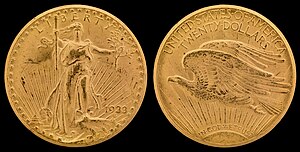
|
A double eagle is a gold coin of the United States with a denomination of $20. The first double eagle, known as the Liberty Head, was minted from 1849, coinciding with the California Gold Rush. In 1904, President Theodore Roosevelt asked artist Augustus Saint-Gaudens to produce a new coin in an effort to beautify American coinage. The new coin became known as the Saint-Gaudens, and was produced until 1933. The 1933 double eagle is among the most valuable of U.S. coins, with the sole example currently known to be in private hands selling in 2002 for $7,590,020. The coin pictured is a 1933 Saint Gaudens. See other double eagle coins: 1849 Liberty Head; 1866 Liberty Head; 1877 Liberty Head; 1907 Saint Gaudens (Roman, high relief; Roman, ultra high relief, wire edge; Arabic; Arabic and motto; edge detail) Coins: U.S. Mint, National Numismatic Collection, National Museum of American History.
Recently featured:
|
September 12

|
The Obama family was the First Family of the United States during the presidency of Barack Obama, from 2009 to 2017. Michelle Obama, Barack's wife, was raised on the South Side of Chicago, graduated from Princeton University and Harvard Law School, and met her husband while they worked at the law firm Sidley Austin. She campaigned actively during his two presidential campaigns, and as First Lady sought to become a role model for women and advocate for poverty awareness. The couple's children are Malia (born 1998) and Sasha (born 2001). Photograph: Pete Souza
Recently featured:
|
September 13
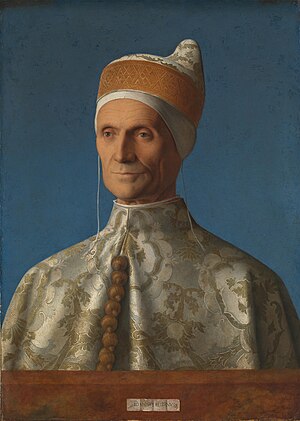
|
Leonardo Loredan (1436–1521) was the 75th doge of the Republic of Venice from 1501 until his death. Loredan's reign began during the disastrous second Ottoman–Venetian War, which he settled with a peace treaty in 1503 at the cost of considerable loss of territory. Later that year a dispute arose between Loredan and Pope Julius II, after Venice occupied territory in the northern Papal States. This escalated into the 1509 War of the League of Cambrai in which Venice was fighting an alliance of the Pope and France. Venice was defeated, but in 1513 Loredan formed a new alliance with the French King Louis XII against Pope Julius. This resulted in a decisive victory. This portrait of Leonardo Loredan was painted by Giovanni Bellini and hangs in the National Gallery, London. Painting: Giovanni Bellini
Recently featured:
|
September 14

|
The Convair NB-36H (bottom) was a converted B-36 Peacemaker bomber, used to test the concept of nuclear-powered aircraft. Built as part of the Aircraft Nuclear Propulsion (ANP) program, the plane carried an operational 1-megawatt nuclear reactor, although this did not power the plane. The NB-36H flew 47 flights between 1955 and 1957, but the ANP program was ultimately canceled. In this flight, the NB-36H is shown shadowed by a Boeing B-50 Superfortress (top). Photograph: United States Air Force
Recently featured:
|
September 15

|
Bath Abbey is an Anglican parish church and Grade I listed building in the English city of Bath. Founded in the 7th century, Bath Abbey was reorganised in the 10th century and rebuilt in the 12th and 16th centuries. It is one of the largest examples of Perpendicular Gothic architecture in the West Country. The cathedral was consolidated to Wells Cathedral in 1539 after the abbey was dissolved in the Dissolution of the Monasteries, but the name of the diocese has remained unchanged. The church is cruciform in plan. Photograph: Diliff
Recently featured:
|
September 16

|
Mexico is a country in North America, bordered by the United States, Guatemala and Belize, and lying between the Pacific and Atlantic Oceans. Pre-Columbian Mexico was home to many advanced civilizations before first contact with Europeans. From 1521 it was colonized by Spain, becoming an independent state three centuries later. September 16 is the country's independence day, commemorating the Cry of Dolores, a declaration which began the Mexican War of Independence in 1810. Pictured is the coat of arms of Mexico, which depicts a Mexican golden eagle devouring a rattlesnake while perched on a prickly pear cactus. The eagle and snake motif is rooted in an Aztec legend. Illustration: Juan Gabino; vectorisation: Alex Covarrubias
Recently featured:
|
September 17

|
Portrait of Dr. Gachet refers to two portraits painted by Dutch artist Vincent van Gogh in 1890, depicting the homeopathic doctor and artist Paul Gachet. Van Gogh was staying with Gachet on the recommendation of his friend Camille Pissarro, having spent a year in a mental asylum following a breakdown. He produced more than seventy paintings during his time with Gachet, including the portraits of his host. The paintings show Gachet with a melancholy face, which Van Gogh described as "the heartbroken expression of our time", seated next to some foxgloves. The portraits of Dr. Gachet were completed just six weeks before Van Gogh shot himself and died from his wounds. The first version of the portrait sold for $82.5 million in 1990, making it at the time the most expensive painting in history. The second version, pictured here, hangs in the Musée d'Orsay in Paris, France. Painting: Vincent van Gogh
Recently featured:
|
September 18
Subpage 1
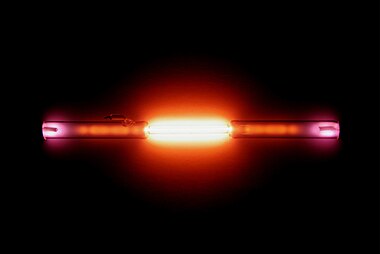
|
The noble gases are a group of chemical elements with similar properties in the periodic table. The six noble gases that occur naturally are helium, neon, argon, krypton, xenon, and the radioactive radon. Under standard conditions, the gases are all colorless, odorless, tasteless and nonflammable. The noble gases show extremely low chemical reactivity, and only a few hundred noble gas compounds have been formed. This picture shows a gas discharge tube containing helium. See images of other noble gases: Neon · Argon · Krypton Photograph: Alchemist-hp
Recently featured:
|
Subpage 2

|
The noble gases are a group of chemical elements with similar properties in the periodic table. The six noble gases that occur naturally are helium, neon, argon, krypton, xenon, and the radioactive radon. Under standard conditions, the gases are all colorless, odorless, tasteless and nonflammable. The noble gases show extremely low chemical reactivity, and only a few hundred noble gas compounds have been formed. This picture shows a gas discharge tube containing neon. See images of other noble gases: Helium · Argon · Krypton Photograph: Alchemist-hp
Recently featured:
|
Subpage 3

|
The noble gases are a group of chemical elements with similar properties in the periodic table. The six noble gases that occur naturally are helium, neon, argon, krypton, xenon, and the radioactive radon. Under standard conditions, the gases are all colorless, odorless, tasteless and nonflammable. The noble gases show extremely low chemical reactivity, and only a few hundred noble gas compounds have been formed. This picture shows a gas discharge tube containing argon. See images of other noble gases: Helium · Neon · Krypton Photograph: Alchemist-hp
Recently featured:
|
Subpage 4

|
The noble gases are a group of chemical elements with similar properties in the periodic table. The six noble gases that occur naturally are helium, neon, argon, krypton, xenon, and the radioactive radon. Under standard conditions, the gases are all colorless, odorless, tasteless and nonflammable. The noble gases show extremely low chemical reactivity, and only a few hundred noble gas compounds have been formed. This picture shows a gas discharge tube containing krypton. See images of other noble gases: Helium · Neon · Argon Photograph: Alchemist-hp
Recently featured:
|
September 19

|
John Philip Sousa (1854–1932) was an American composer and conductor of the late Romantic era, known primarily for American military marches. Showing great talent as a child, he mastered several instruments alongside an apprenticeship in the Marine Corps. After a period as a violinist and theater orchestra conductor, Sousa returned to the Marines for a twelve-year stint as head of the U.S. Marine Band, including two presidential inauguration balls. Later in life, he formed the Sousa Band and saw active service in World War I. He wrote a total of 137 marches, including Stars and Stripes Forever, which was designated the United States national march in 1987. Photograph: Elmer Chickering
Recently featured:
|
September 20

|
A plough is a farm implement that turns over the upper layer of soil, bringing fresh nutrients to the surface as part of preparation for sowing seeds or planting. In early agriculture, soil was turned by hand using digging sticks and hoes. The first animal-drawn plough was the ard, with the earliest evidence of a ploughed field dating to the Indus Valley Civilisation site of Kalibangan from around 2800 B.C. Wheels were introduced by Celtic peoples during the Roman era, and the mouldboard plough, a major innovation in plough technology, was invented in the 18th century. Modern ploughs are usually reversible ploughs, mounted on a tractor. This painting, Ploughing in the Nivernais, was completed by the French artist Rosa Bonheur in 1849 and is now in the Musée d'Orsay in Paris. Painting: Rosa Bonheur
Recently featured:
|
September 21

|
Caroline Schermerhorn Astor (September 21, 1830 – October 30, 1908) was a prominent American socialite of the second half of the 19th century. Born into a wealthy family from New York City's Dutch aristocracy, she married William Backhouse Astor Jr. in 1853. The Astor family had made a fortune through fur trading and real estate. Mrs. Astor became a leading member of the exclusive New York aristocratic society of inherited wealth; by the end of the 19th century she was known as the Mrs. Astor. Adjacent Astor family homes that she had occupied at different times on Fifth Avenue became the first Waldorf–Astoria hotel, and later the site of the Empire State Building. Painting: Carolus-Duran, 1890; Metropolitan Museum of Art
Recently featured:
|
September 22

|
Christiansborg Palace is a building in the Danish capital, Copenhagen. It is the seat of the Danish Parliament, the Office of the Prime Minister, and the Supreme Court. The first castle on the site was Absalon's Castle, built in 1167 by the bishop Absalon and demolished in 1370, after King Valdemar was defeated by the Hanseatic League. By the end of the 14th century Copenhagen Castle was built on the site but that too was demolished in 1731. The first Christiansborg was then built, on the orders of King Christian VI, becoming the largest palace in northern Europe on its completion in 1745. It was destroyed in 1794 by fire, and replaced by the second Christiansborg. That too burned down in 1884, eventually being replaced by the current building, which was built between 1907 and 1928. The modern building is neo-Baroque in style, although the 19th-century neoclassical chapel and the original Baroque riding grounds remain, having survived the fires. Photograph: Julian Herzog
Recently featured:
|
September 23

|
Lady Seated at a Virginal is a painting by Dutch artist Johannes Vermeer painted in approximately 1670–72. It shows a woman playing a virginal, with a viola da gamba depicted in the foreground, its bow between the strings. There is a painting depicted on the wall, which is either the original or a copy of Dirck van Baburen's The Procuress. It is one of several works by Vermeer featuring keyboard instruments, including The Music Lesson, The Concert, and Lady Standing at a Virginal. Scholars believe these may all be based on the same instrument, built by Johannes Ruckers. Lady Seated at a Virginal is in the National Gallery, London. Painting: Johannes Vermeer
Recently featured:
|
September 24

|
Steven Chu (born 1948) is an American physicist and former government official. Born in St Louis into a family with Chinese ancestry, Chu studied at the University of Rochester and then earned a PhD in physics at the University of California, Berkeley. He became a researcher, first at Bell Labs and then later as a professor at Stanford University. In 1997 he was awarded the Nobel Prize in Physics, along with two colleagues, for the "development of methods to cool and trap atoms with laser light". In 2009, Chu was appointed United States Secretary of Energy in the first administration of president Barack Obama, a position he held until 2013. Photograph: Royal Society uploader
Recently featured:
|
September 25

|
Cornelis Kruseman (25 September 1797 – 14 November 1857) was a Dutch painter. Born in Amsterdam, he studied art with Charles Howard Hodges and Jean Augustin Daiwaille before moving to Italy via Paris in 1821. He remained in Italy for four years, working with and learning from artists Jean-Victor Schnetz and Louis Léopold Robert, and then moved back to the Netherlands and settled in The Hague. He lived in Italy again from 1841 to 1848, leading him to be called the "Italian Kruseman", before returning once more to the Netherlands for the rest of his life. His works included portraits, biblical scenes, and depictions of Italian peasant life. This picture is a self-portrait of Kruseman, which hangs in the Museum Van Loon in Amsterdam. Painting: Cornelis Kruseman
Recently featured:
|
September 26
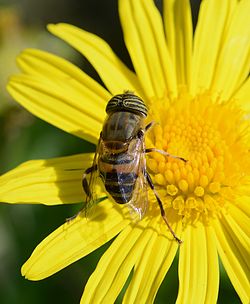
|
Eristalinus taeniops, also known as the band-eyed drone fly, is a species of hoverfly found in parts of Europe, the Middle East and Africa. Photograph: Joaquim Alves Gaspar
Recently featured:
|
September 27

|
|
Divorce is the process of terminating a marriage. Divorce laws vary considerably around the world, but in most countries divorce requires the sanction of a court or other authority in a legal process, which involves issues such as distribution of property and child custody. Common reasons for divorce include adultery, domestic violence, midlife crises, addiction, and workaholism. This is a cartoon by Samuel D. Ehrhart, titled An International High Noon Divorce. It parodies the circus-like proceedings during the divorce of American socialite Anna Gould from her husband Boni de Castellane, a French nobleman. Cartoon: Samuel D. Ehrhart. Restoration: Adam Cuerden
Recently featured:
|
September 28

|
The Travelling Companions is an 1862 painting by English artist Augustus Egg. It was created towards the end of Egg's life, at a time when he travelled abroad frequently to seek relief from life-long asthma. The painting depicts two similar-looking and identically dressed women seated opposite each other in a compartment aboard a train travelling along the coastline of Menton, on the French Riviera. The symmetry of the women and the compartment itself is broken in that one woman is sleeping next to a basket of fruit, while the other is reading beside a bouquet of flowers. The painting is in the Birmingham Museum and Art Gallery. Painting: Augustus Egg
Recently featured:
|
September 29

|
|
Yerevan is the capital and largest city of Armenia, and one of the world's oldest continuously inhabited cities. It was founded as the Erebuni Fortress in 782 BC by King Argishti I of Urartu, who designed it as his capital. By the late ancient Armenian Kingdom, however, new capital cities were established and Yerevan declined in importance. It was revived in 1582 when it was taken over by the Ottoman Turks, who were in conflict with Iran. The city changed hands multiple times from 1604 to the 1720s, when Iran emerged victorious. In 1827 it was taken over by Russia. After a brief spell as capital of independent Armenia from 1920, it fell under Soviet rule, before emerging as capital of the modern republic in 1991. The city became an important industrial centre under Soviet rule, and is now Armenia's primary political and cultural hub. This picture shows Yerevan with Mount Ararat, which dominates the skyline and is a national symbol. Photograph: Serouj.
Recently featured:
|
September 30

|
Renée Adorée (30 September 1898 – 5 October 1933) was a French actress. Born into a family of circus performers in Lille, France, she performed regularly with her parents as a child. Having made a reputation in France, England, and Australia for her dancing skills, she went to New York City in 1919, where she was cast in musicals including Oh, Uncle, Oh, What a Girl, and Dancer. In 1920, she appeared in her first film, Raoul Walsh's The Strongest, as the lead character. She went on to star in several silent films in the early 1920s, including Reginald Barker's The Eternal Struggle, which established her as a Hollywood star. The biggest role of her career was as Melisande in 1925's melodramatic romance and war epic The Big Parade opposite John Gilbert. It became one of MGM's all-time biggest hits and a film that historians rank as one of the best of the silent era. She continued making films into the 1930s including two with all-talking roles, but developed tuberculosis and died in 1933. Photograph: Bain News Service
Recently featured:
|
Picture of the day archives and future dates